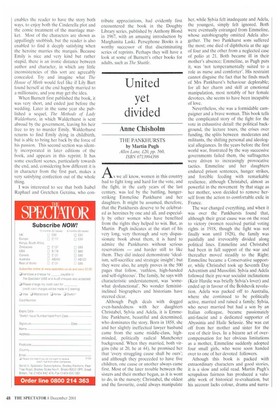The marriage market
Charlotte Mitchell
THE MAKING OF A MARCHIONESS by Frances Hodgson Burnett Persephone Books, £10, pp. 328, ISBN 1903155142 Frances Hodgson Burnett was much given to lavish displays of affectionate generosity. Delightful surprises, presents. holidays and money were showered not only on her idolised sons, but on sundry nephews, godchildren and other hangers-on. Her brief reign as Lady Bountiful in an English manor house was remembered by villagers as a halcyon period of school treats and festivities. Again and again in her novels, too, the cold are warmed, the hungry are fed and children suddenly find themselves in nurseries stuffed with every imaginable toy. The most memorable of these scenes is that in A Little Princess when Sara Crewe goes hungrily into her attic and finds a feast laid out and the room transformed into a palace, but there are versions in almost all her books.
The Making of a Marchioness (1901), a novel for adults, is not one of the exceptions. The heroine is a good-tempered, well-born lady of inadequate income and only ordinary intellectual and educational qualifications, who must somehow keep herself from starvation without losing caste, This character had long preoccupied novelists of Burnett's generation, and still figured in George Orwell's imagination as the 'colonel's daughter with 1.60 a year'. Emily Fox-Seton struggles to live in London running errands, doing bits of journalism, and working her fingers to the bone to keep her clothes respectable. Burnett evokes the sordid reality of her situation with great skill. Staying at a house party in the summer, Emily watches the middleaged, immensely rich Marquis of Walderhurst being openly pursued by an American heiress, an English debutante and a literary widow. When he proposes to her she is so amazed at first she thinks he is trying to seduce her, but when it is clear he means marriage she falls pathetically in love with him.
Burnett carefully indicates to the reader her own awareness that marquises are not fairy princes, but since this one is for Emily, what does it matter? The singular charm of the book is the way it happily
enables the reader to have the story both ways, to enjoy both the Cinderella plot and the comic treatment of the marriage market. Most of the characters are shown as appallingly snobbish, but the reader is also enabled to find it deeply satisfying when the heroine marries the marquis. Because Emily is nice and very kind but rather stupid, there is an ironic distance between author and character, in which any little inconsistencies of this sort are agreeably concealed. Try and imagine what The House of Mirth would feel like if Lily Bart found herself at the end happily married to a millionaire, and you may get the idea.
When Burnett first published the book, it was very short, and ended just before the wedding. Later in the same year she published a sequel, The Methods of Lady Walderhurst, in which Walderhurst is sent abroad by the government, leaving his heir free to try to murder Emily. Walderhurst returns to find Emily dying in childbirth, but is able to bring her back by the force of his passion. This second section was silently incorporated in later editions of the book, and appears in this reprint. It has some excellent scenes, particularly towards the end, and, considering how different it is in character from the first part, makes a very satisfying confection out of the whole thing.
I was interested to see that both Isabel Raphael and Gretchen Gerzina, who con tribute appreciations, had evidently first encountered the book in the Doughty Library series, published by Anthony Blond in 1967, with an amusing introduction by Marghanita Laski. Persephone Books is a worthy successor of that discriminating series of reprints. Perhaps they will have a look at some of Burnett's other books for adults, such as The Shuttle.























































































 Previous page
Previous page